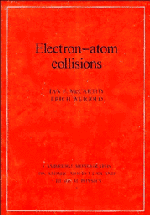Book contents
- Frontmatter
- Contents
- Preface
- 1 Introduction
- 2 Experimental techniques for cross-section measurements
- 3 Background quantum mechanics in the atomic context
- 4 One-electron problems
- 5 Theory of atomic bound states
- 6 Formal scattering theory
- 7 Calculation of scattering amplitudes
- 8 Spin-independent scattering observables
- 9 Spin-dependent scattering observables
- 10 Ionisation
- 11 Electron momentum spectroscopy
- References
- Index
6 - Formal scattering theory
Published online by Cambridge University Press: 15 December 2009
- Frontmatter
- Contents
- Preface
- 1 Introduction
- 2 Experimental techniques for cross-section measurements
- 3 Background quantum mechanics in the atomic context
- 4 One-electron problems
- 5 Theory of atomic bound states
- 6 Formal scattering theory
- 7 Calculation of scattering amplitudes
- 8 Spin-independent scattering observables
- 9 Spin-dependent scattering observables
- 10 Ionisation
- 11 Electron momentum spectroscopy
- References
- Index
Summary
We have considered the measurement of observables in electron–atom collisions and the description of the structure of the target and residual atomic states. We are now in a position to develop the formal theory of the reaction mechanism. Our understanding of potential scattering serves as a useful example of the concepts involved.
Reactions are understood in terms of channels. A channel is a quantum state of the projectile–target system when the projectile and target are so far apart that they do not interact. It is specified by the incident energy and spin projection of the projectile and the quantum state of the N-electron target, which may be bound or ionised.
The reaction mechanism is studied by considering targets whose description is simple and, at least from the spectroscopic point of view, believable within an accuracy appropriate to the scattering experiment. Hydrogen is the obvious example, although experiments are difficult because of the need to make the atomic target by dissociating molecules. Sodium is a target for which a large quantity of experimental data is available and whose structure can be quite well described for the lower-energy states. When the reaction mechanism is sufficiently understood the reaction may be used as a probe for the structure of more-complicated target or residual systems.
Formulation of the problem
Scattering theory concerns a collision of two bodies, that may change the state of one or both of the bodies. In our application one body (the projectile) is an electron, whose internal state is specified by its spin-projection quantum number v.
- Type
- Chapter
- Information
- Electron-Atom Collisions , pp. 139 - 155Publisher: Cambridge University PressPrint publication year: 1995

